Corporate Governance and Fraud Analysis: Enron and Fujifilm Scandals
VerifiedAdded on 2022/10/15
|9
|2098
|435
Report
AI Summary
This report provides a comprehensive analysis of corporate governance and fraud, focusing on the Enron and Fujifilm scandals. It investigates the causes of these financial malpractices, including weak internal control systems, aggressive accounting methods, and ethical failures within the organizations. The report examines the specific actions taken by management, the role of audit committees, and the impact on stakeholders. It also explores the solutions to prevent future scandals, such as strengthening internal control systems, empowering audit committees, and promoting ethical compliance. The report highlights the importance of legal and ethical compliance in corporate governance and the need for robust mechanisms to detect and deter fraudulent activities. The analysis emphasizes the significance of transparency, accountability, and responsible decision-making in maintaining financial integrity and protecting the interests of all stakeholders.
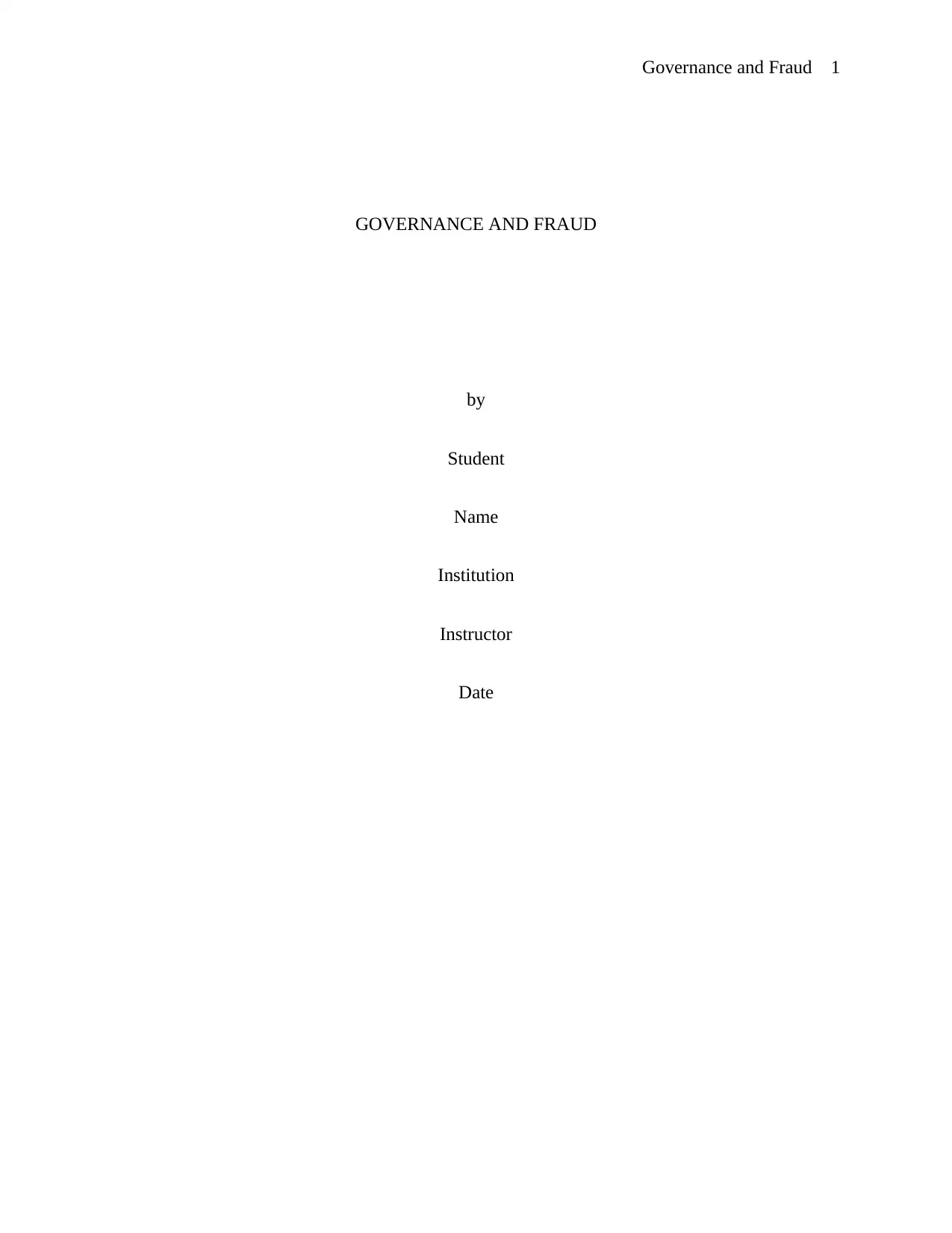
Governance and Fraud 1
GOVERNANCE AND FRAUD
by
Student
Name
Institution
Instructor
Date
GOVERNANCE AND FRAUD
by
Student
Name
Institution
Instructor
Date
Paraphrase This Document
Need a fresh take? Get an instant paraphrase of this document with our AI Paraphraser
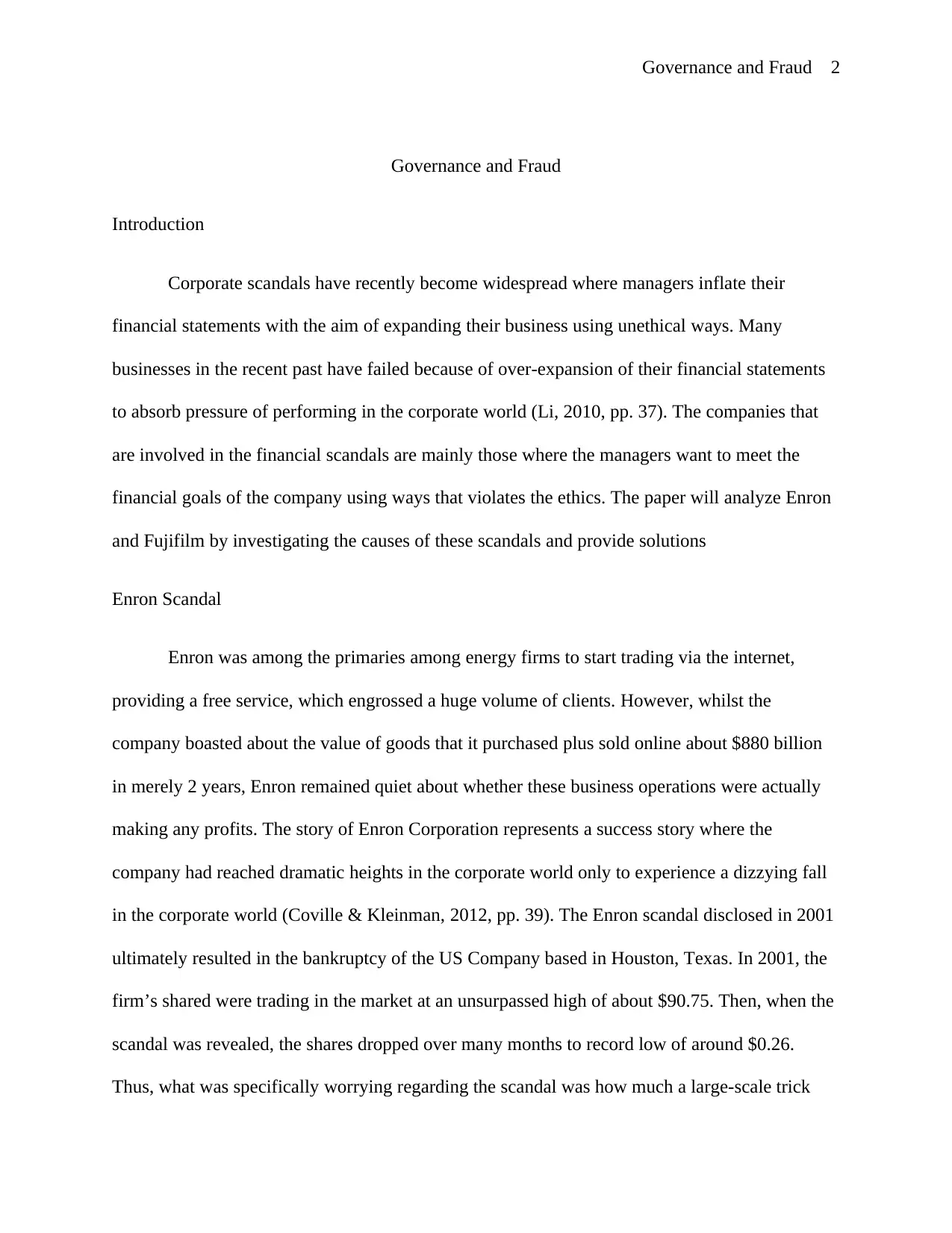
Governance and Fraud 2
Governance and Fraud
Introduction
Corporate scandals have recently become widespread where managers inflate their
financial statements with the aim of expanding their business using unethical ways. Many
businesses in the recent past have failed because of over-expansion of their financial statements
to absorb pressure of performing in the corporate world (Li, 2010, pp. 37). The companies that
are involved in the financial scandals are mainly those where the managers want to meet the
financial goals of the company using ways that violates the ethics. The paper will analyze Enron
and Fujifilm by investigating the causes of these scandals and provide solutions
Enron Scandal
Enron was among the primaries among energy firms to start trading via the internet,
providing a free service, which engrossed a huge volume of clients. However, whilst the
company boasted about the value of goods that it purchased plus sold online about $880 billion
in merely 2 years, Enron remained quiet about whether these business operations were actually
making any profits. The story of Enron Corporation represents a success story where the
company had reached dramatic heights in the corporate world only to experience a dizzying fall
in the corporate world (Coville & Kleinman, 2012, pp. 39). The Enron scandal disclosed in 2001
ultimately resulted in the bankruptcy of the US Company based in Houston, Texas. In 2001, the
firm’s shared were trading in the market at an unsurpassed high of about $90.75. Then, when the
scandal was revealed, the shares dropped over many months to record low of around $0.26.
Thus, what was specifically worrying regarding the scandal was how much a large-scale trick
Governance and Fraud
Introduction
Corporate scandals have recently become widespread where managers inflate their
financial statements with the aim of expanding their business using unethical ways. Many
businesses in the recent past have failed because of over-expansion of their financial statements
to absorb pressure of performing in the corporate world (Li, 2010, pp. 37). The companies that
are involved in the financial scandals are mainly those where the managers want to meet the
financial goals of the company using ways that violates the ethics. The paper will analyze Enron
and Fujifilm by investigating the causes of these scandals and provide solutions
Enron Scandal
Enron was among the primaries among energy firms to start trading via the internet,
providing a free service, which engrossed a huge volume of clients. However, whilst the
company boasted about the value of goods that it purchased plus sold online about $880 billion
in merely 2 years, Enron remained quiet about whether these business operations were actually
making any profits. The story of Enron Corporation represents a success story where the
company had reached dramatic heights in the corporate world only to experience a dizzying fall
in the corporate world (Coville & Kleinman, 2012, pp. 39). The Enron scandal disclosed in 2001
ultimately resulted in the bankruptcy of the US Company based in Houston, Texas. In 2001, the
firm’s shared were trading in the market at an unsurpassed high of about $90.75. Then, when the
scandal was revealed, the shares dropped over many months to record low of around $0.26.
Thus, what was specifically worrying regarding the scandal was how much a large-scale trick
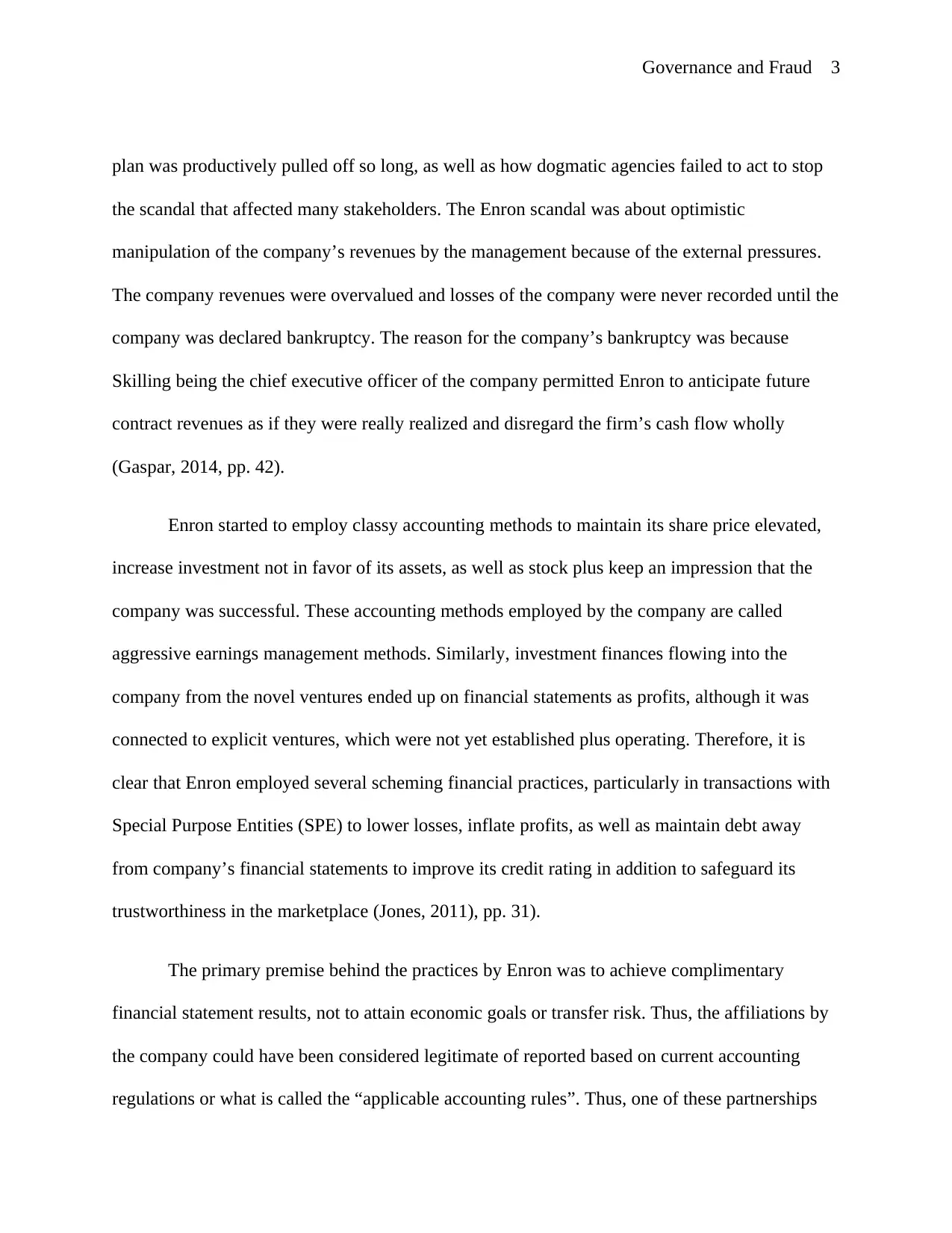
Governance and Fraud 3
plan was productively pulled off so long, as well as how dogmatic agencies failed to act to stop
the scandal that affected many stakeholders. The Enron scandal was about optimistic
manipulation of the company’s revenues by the management because of the external pressures.
The company revenues were overvalued and losses of the company were never recorded until the
company was declared bankruptcy. The reason for the company’s bankruptcy was because
Skilling being the chief executive officer of the company permitted Enron to anticipate future
contract revenues as if they were really realized and disregard the firm’s cash flow wholly
(Gaspar, 2014, pp. 42).
Enron started to employ classy accounting methods to maintain its share price elevated,
increase investment not in favor of its assets, as well as stock plus keep an impression that the
company was successful. These accounting methods employed by the company are called
aggressive earnings management methods. Similarly, investment finances flowing into the
company from the novel ventures ended up on financial statements as profits, although it was
connected to explicit ventures, which were not yet established plus operating. Therefore, it is
clear that Enron employed several scheming financial practices, particularly in transactions with
Special Purpose Entities (SPE) to lower losses, inflate profits, as well as maintain debt away
from company’s financial statements to improve its credit rating in addition to safeguard its
trustworthiness in the marketplace (Jones, 2011), pp. 31).
The primary premise behind the practices by Enron was to achieve complimentary
financial statement results, not to attain economic goals or transfer risk. Thus, the affiliations by
the company could have been considered legitimate of reported based on current accounting
regulations or what is called the “applicable accounting rules”. Thus, one of these partnerships
plan was productively pulled off so long, as well as how dogmatic agencies failed to act to stop
the scandal that affected many stakeholders. The Enron scandal was about optimistic
manipulation of the company’s revenues by the management because of the external pressures.
The company revenues were overvalued and losses of the company were never recorded until the
company was declared bankruptcy. The reason for the company’s bankruptcy was because
Skilling being the chief executive officer of the company permitted Enron to anticipate future
contract revenues as if they were really realized and disregard the firm’s cash flow wholly
(Gaspar, 2014, pp. 42).
Enron started to employ classy accounting methods to maintain its share price elevated,
increase investment not in favor of its assets, as well as stock plus keep an impression that the
company was successful. These accounting methods employed by the company are called
aggressive earnings management methods. Similarly, investment finances flowing into the
company from the novel ventures ended up on financial statements as profits, although it was
connected to explicit ventures, which were not yet established plus operating. Therefore, it is
clear that Enron employed several scheming financial practices, particularly in transactions with
Special Purpose Entities (SPE) to lower losses, inflate profits, as well as maintain debt away
from company’s financial statements to improve its credit rating in addition to safeguard its
trustworthiness in the marketplace (Jones, 2011), pp. 31).
The primary premise behind the practices by Enron was to achieve complimentary
financial statement results, not to attain economic goals or transfer risk. Thus, the affiliations by
the company could have been considered legitimate of reported based on current accounting
regulations or what is called the “applicable accounting rules”. Thus, one of these partnerships
⊘ This is a preview!⊘
Do you want full access?
Subscribe today to unlock all pages.

Trusted by 1+ million students worldwide
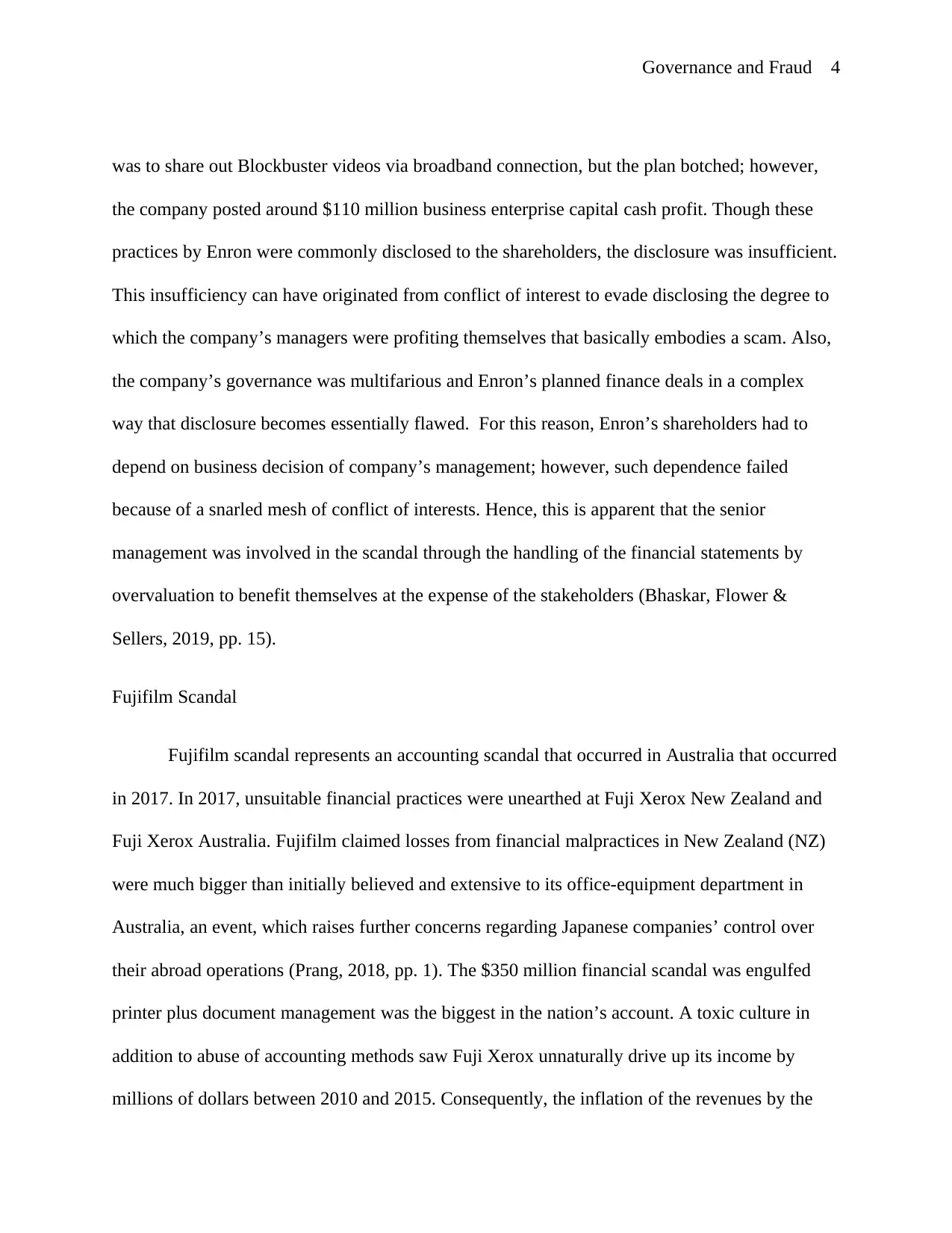
Governance and Fraud 4
was to share out Blockbuster videos via broadband connection, but the plan botched; however,
the company posted around $110 million business enterprise capital cash profit. Though these
practices by Enron were commonly disclosed to the shareholders, the disclosure was insufficient.
This insufficiency can have originated from conflict of interest to evade disclosing the degree to
which the company’s managers were profiting themselves that basically embodies a scam. Also,
the company’s governance was multifarious and Enron’s planned finance deals in a complex
way that disclosure becomes essentially flawed. For this reason, Enron’s shareholders had to
depend on business decision of company’s management; however, such dependence failed
because of a snarled mesh of conflict of interests. Hence, this is apparent that the senior
management was involved in the scandal through the handling of the financial statements by
overvaluation to benefit themselves at the expense of the stakeholders (Bhaskar, Flower &
Sellers, 2019, pp. 15).
Fujifilm Scandal
Fujifilm scandal represents an accounting scandal that occurred in Australia that occurred
in 2017. In 2017, unsuitable financial practices were unearthed at Fuji Xerox New Zealand and
Fuji Xerox Australia. Fujifilm claimed losses from financial malpractices in New Zealand (NZ)
were much bigger than initially believed and extensive to its office-equipment department in
Australia, an event, which raises further concerns regarding Japanese companies’ control over
their abroad operations (Prang, 2018, pp. 1). The $350 million financial scandal was engulfed
printer plus document management was the biggest in the nation’s account. A toxic culture in
addition to abuse of accounting methods saw Fuji Xerox unnaturally drive up its income by
millions of dollars between 2010 and 2015. Consequently, the inflation of the revenues by the
was to share out Blockbuster videos via broadband connection, but the plan botched; however,
the company posted around $110 million business enterprise capital cash profit. Though these
practices by Enron were commonly disclosed to the shareholders, the disclosure was insufficient.
This insufficiency can have originated from conflict of interest to evade disclosing the degree to
which the company’s managers were profiting themselves that basically embodies a scam. Also,
the company’s governance was multifarious and Enron’s planned finance deals in a complex
way that disclosure becomes essentially flawed. For this reason, Enron’s shareholders had to
depend on business decision of company’s management; however, such dependence failed
because of a snarled mesh of conflict of interests. Hence, this is apparent that the senior
management was involved in the scandal through the handling of the financial statements by
overvaluation to benefit themselves at the expense of the stakeholders (Bhaskar, Flower &
Sellers, 2019, pp. 15).
Fujifilm Scandal
Fujifilm scandal represents an accounting scandal that occurred in Australia that occurred
in 2017. In 2017, unsuitable financial practices were unearthed at Fuji Xerox New Zealand and
Fuji Xerox Australia. Fujifilm claimed losses from financial malpractices in New Zealand (NZ)
were much bigger than initially believed and extensive to its office-equipment department in
Australia, an event, which raises further concerns regarding Japanese companies’ control over
their abroad operations (Prang, 2018, pp. 1). The $350 million financial scandal was engulfed
printer plus document management was the biggest in the nation’s account. A toxic culture in
addition to abuse of accounting methods saw Fuji Xerox unnaturally drive up its income by
millions of dollars between 2010 and 2015. Consequently, the inflation of the revenues by the
Paraphrase This Document
Need a fresh take? Get an instant paraphrase of this document with our AI Paraphraser
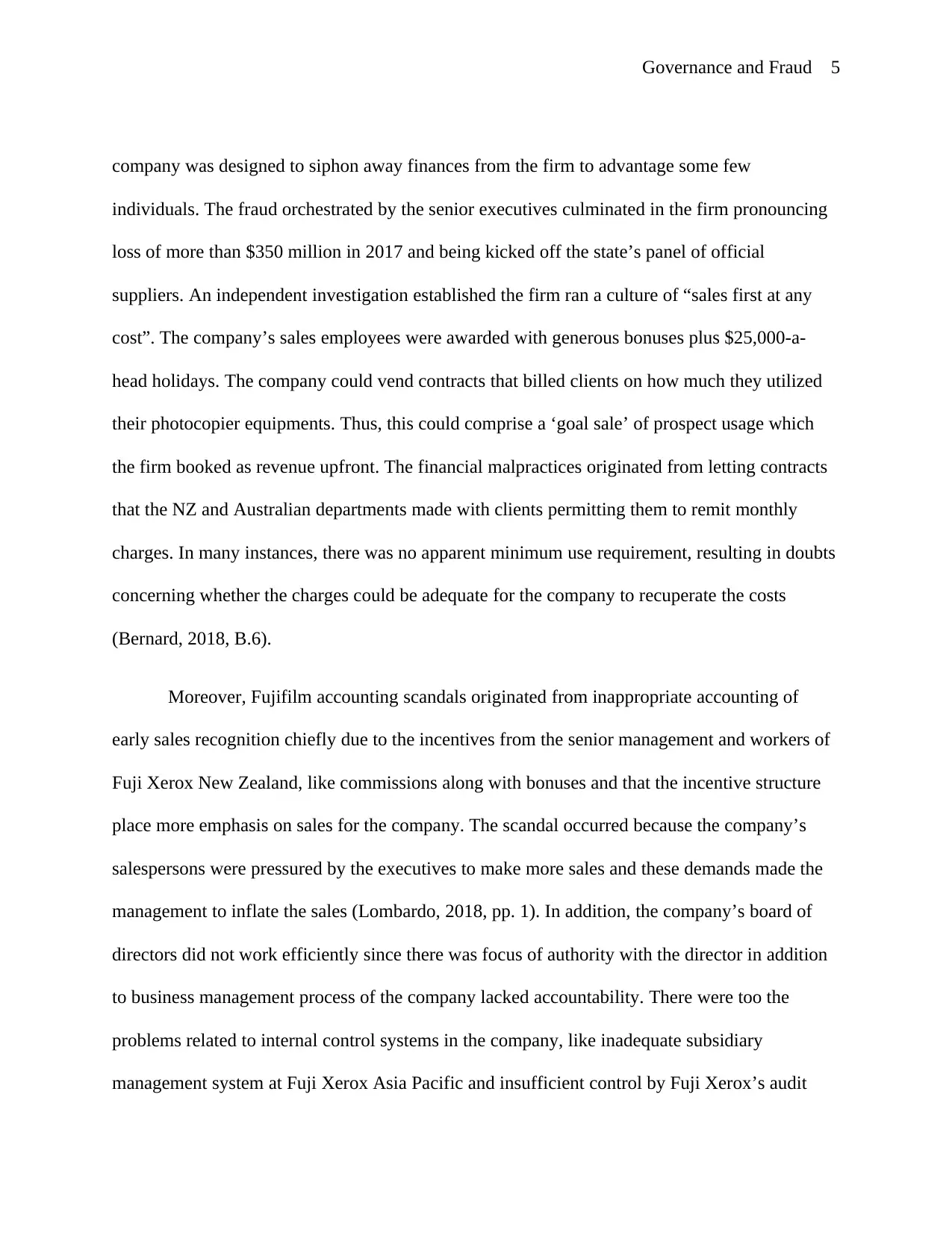
Governance and Fraud 5
company was designed to siphon away finances from the firm to advantage some few
individuals. The fraud orchestrated by the senior executives culminated in the firm pronouncing
loss of more than $350 million in 2017 and being kicked off the state’s panel of official
suppliers. An independent investigation established the firm ran a culture of “sales first at any
cost”. The company’s sales employees were awarded with generous bonuses plus $25,000-a-
head holidays. The company could vend contracts that billed clients on how much they utilized
their photocopier equipments. Thus, this could comprise a ‘goal sale’ of prospect usage which
the firm booked as revenue upfront. The financial malpractices originated from letting contracts
that the NZ and Australian departments made with clients permitting them to remit monthly
charges. In many instances, there was no apparent minimum use requirement, resulting in doubts
concerning whether the charges could be adequate for the company to recuperate the costs
(Bernard, 2018, B.6).
Moreover, Fujifilm accounting scandals originated from inappropriate accounting of
early sales recognition chiefly due to the incentives from the senior management and workers of
Fuji Xerox New Zealand, like commissions along with bonuses and that the incentive structure
place more emphasis on sales for the company. The scandal occurred because the company’s
salespersons were pressured by the executives to make more sales and these demands made the
management to inflate the sales (Lombardo, 2018, pp. 1). In addition, the company’s board of
directors did not work efficiently since there was focus of authority with the director in addition
to business management process of the company lacked accountability. There were too the
problems related to internal control systems in the company, like inadequate subsidiary
management system at Fuji Xerox Asia Pacific and insufficient control by Fuji Xerox’s audit
company was designed to siphon away finances from the firm to advantage some few
individuals. The fraud orchestrated by the senior executives culminated in the firm pronouncing
loss of more than $350 million in 2017 and being kicked off the state’s panel of official
suppliers. An independent investigation established the firm ran a culture of “sales first at any
cost”. The company’s sales employees were awarded with generous bonuses plus $25,000-a-
head holidays. The company could vend contracts that billed clients on how much they utilized
their photocopier equipments. Thus, this could comprise a ‘goal sale’ of prospect usage which
the firm booked as revenue upfront. The financial malpractices originated from letting contracts
that the NZ and Australian departments made with clients permitting them to remit monthly
charges. In many instances, there was no apparent minimum use requirement, resulting in doubts
concerning whether the charges could be adequate for the company to recuperate the costs
(Bernard, 2018, B.6).
Moreover, Fujifilm accounting scandals originated from inappropriate accounting of
early sales recognition chiefly due to the incentives from the senior management and workers of
Fuji Xerox New Zealand, like commissions along with bonuses and that the incentive structure
place more emphasis on sales for the company. The scandal occurred because the company’s
salespersons were pressured by the executives to make more sales and these demands made the
management to inflate the sales (Lombardo, 2018, pp. 1). In addition, the company’s board of
directors did not work efficiently since there was focus of authority with the director in addition
to business management process of the company lacked accountability. There were too the
problems related to internal control systems in the company, like inadequate subsidiary
management system at Fuji Xerox Asia Pacific and insufficient control by Fuji Xerox’s audit
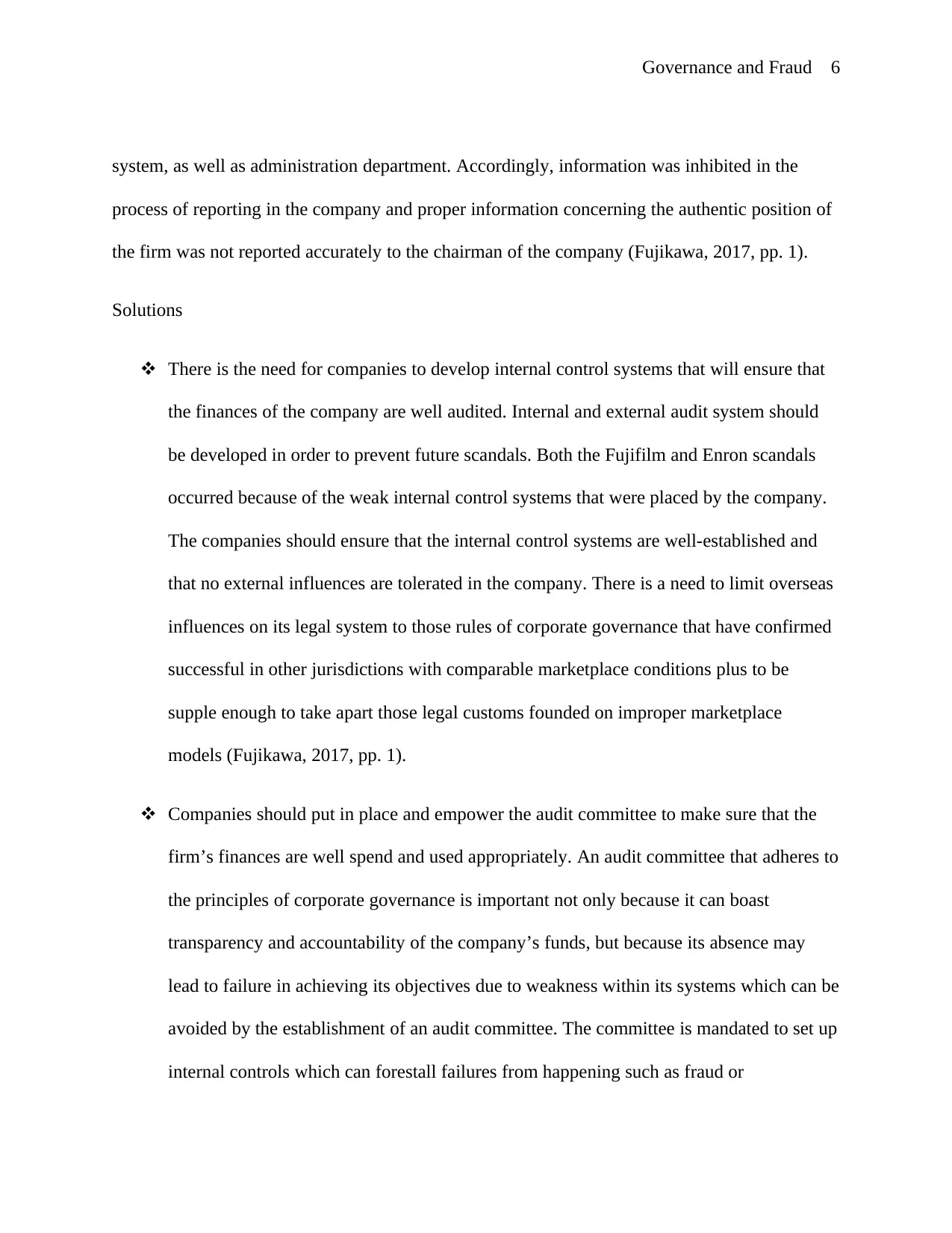
Governance and Fraud 6
system, as well as administration department. Accordingly, information was inhibited in the
process of reporting in the company and proper information concerning the authentic position of
the firm was not reported accurately to the chairman of the company (Fujikawa, 2017, pp. 1).
Solutions
There is the need for companies to develop internal control systems that will ensure that
the finances of the company are well audited. Internal and external audit system should
be developed in order to prevent future scandals. Both the Fujifilm and Enron scandals
occurred because of the weak internal control systems that were placed by the company.
The companies should ensure that the internal control systems are well-established and
that no external influences are tolerated in the company. There is a need to limit overseas
influences on its legal system to those rules of corporate governance that have confirmed
successful in other jurisdictions with comparable marketplace conditions plus to be
supple enough to take apart those legal customs founded on improper marketplace
models (Fujikawa, 2017, pp. 1).
Companies should put in place and empower the audit committee to make sure that the
firm’s finances are well spend and used appropriately. An audit committee that adheres to
the principles of corporate governance is important not only because it can boast
transparency and accountability of the company’s funds, but because its absence may
lead to failure in achieving its objectives due to weakness within its systems which can be
avoided by the establishment of an audit committee. The committee is mandated to set up
internal controls which can forestall failures from happening such as fraud or
system, as well as administration department. Accordingly, information was inhibited in the
process of reporting in the company and proper information concerning the authentic position of
the firm was not reported accurately to the chairman of the company (Fujikawa, 2017, pp. 1).
Solutions
There is the need for companies to develop internal control systems that will ensure that
the finances of the company are well audited. Internal and external audit system should
be developed in order to prevent future scandals. Both the Fujifilm and Enron scandals
occurred because of the weak internal control systems that were placed by the company.
The companies should ensure that the internal control systems are well-established and
that no external influences are tolerated in the company. There is a need to limit overseas
influences on its legal system to those rules of corporate governance that have confirmed
successful in other jurisdictions with comparable marketplace conditions plus to be
supple enough to take apart those legal customs founded on improper marketplace
models (Fujikawa, 2017, pp. 1).
Companies should put in place and empower the audit committee to make sure that the
firm’s finances are well spend and used appropriately. An audit committee that adheres to
the principles of corporate governance is important not only because it can boast
transparency and accountability of the company’s funds, but because its absence may
lead to failure in achieving its objectives due to weakness within its systems which can be
avoided by the establishment of an audit committee. The committee is mandated to set up
internal controls which can forestall failures from happening such as fraud or
⊘ This is a preview!⊘
Do you want full access?
Subscribe today to unlock all pages.

Trusted by 1+ million students worldwide
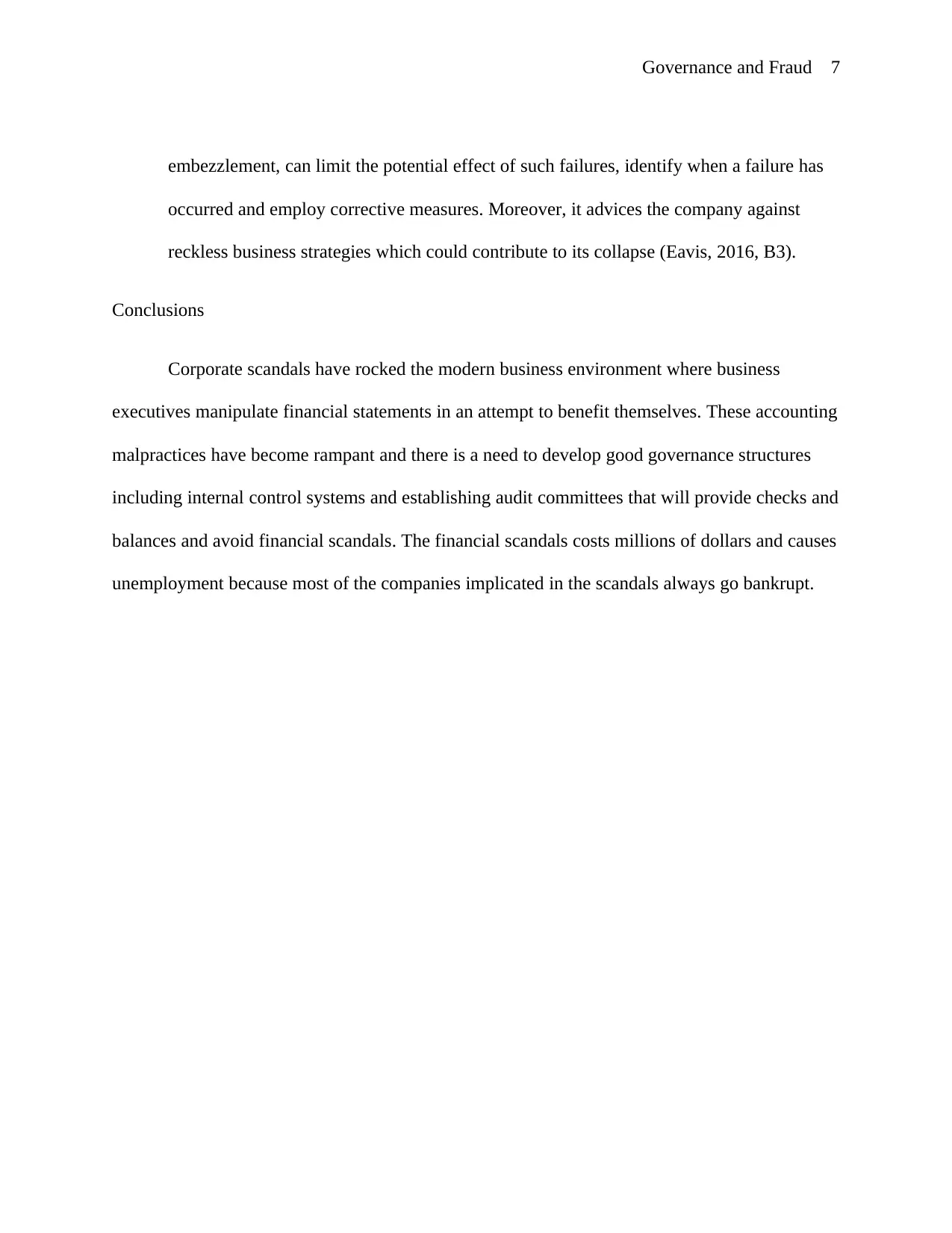
Governance and Fraud 7
embezzlement, can limit the potential effect of such failures, identify when a failure has
occurred and employ corrective measures. Moreover, it advices the company against
reckless business strategies which could contribute to its collapse (Eavis, 2016, B3).
Conclusions
Corporate scandals have rocked the modern business environment where business
executives manipulate financial statements in an attempt to benefit themselves. These accounting
malpractices have become rampant and there is a need to develop good governance structures
including internal control systems and establishing audit committees that will provide checks and
balances and avoid financial scandals. The financial scandals costs millions of dollars and causes
unemployment because most of the companies implicated in the scandals always go bankrupt.
embezzlement, can limit the potential effect of such failures, identify when a failure has
occurred and employ corrective measures. Moreover, it advices the company against
reckless business strategies which could contribute to its collapse (Eavis, 2016, B3).
Conclusions
Corporate scandals have rocked the modern business environment where business
executives manipulate financial statements in an attempt to benefit themselves. These accounting
malpractices have become rampant and there is a need to develop good governance structures
including internal control systems and establishing audit committees that will provide checks and
balances and avoid financial scandals. The financial scandals costs millions of dollars and causes
unemployment because most of the companies implicated in the scandals always go bankrupt.
Paraphrase This Document
Need a fresh take? Get an instant paraphrase of this document with our AI Paraphraser
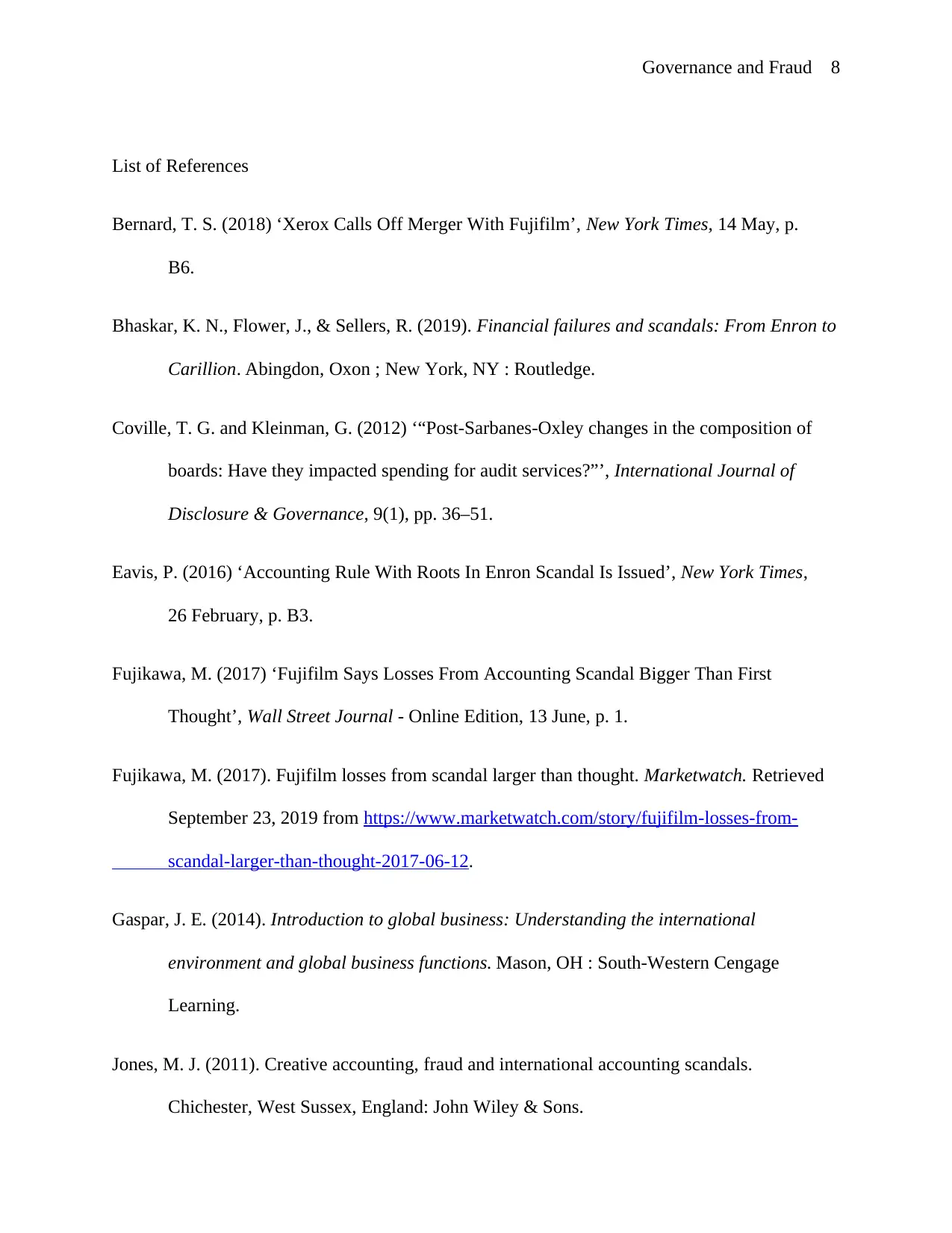
Governance and Fraud 8
List of References
Bernard, T. S. (2018) ‘Xerox Calls Off Merger With Fujifilm’, New York Times, 14 May, p.
B6.
Bhaskar, K. N., Flower, J., & Sellers, R. (2019). Financial failures and scandals: From Enron to
Carillion. Abingdon, Oxon ; New York, NY : Routledge.
Coville, T. G. and Kleinman, G. (2012) ‘“Post-Sarbanes-Oxley changes in the composition of
boards: Have they impacted spending for audit services?”’, International Journal of
Disclosure & Governance, 9(1), pp. 36–51.
Eavis, P. (2016) ‘Accounting Rule With Roots In Enron Scandal Is Issued’, New York Times,
26 February, p. B3.
Fujikawa, M. (2017) ‘Fujifilm Says Losses From Accounting Scandal Bigger Than First
Thought’, Wall Street Journal - Online Edition, 13 June, p. 1.
Fujikawa, M. (2017). Fujifilm losses from scandal larger than thought. Marketwatch. Retrieved
September 23, 2019 from https://www.marketwatch.com/story/fujifilm-losses-from-
scandal-larger-than-thought-2017-06-12.
Gaspar, J. E. (2014). Introduction to global business: Understanding the international
environment and global business functions. Mason, OH : South-Western Cengage
Learning.
Jones, M. J. (2011). Creative accounting, fraud and international accounting scandals.
Chichester, West Sussex, England: John Wiley & Sons.
List of References
Bernard, T. S. (2018) ‘Xerox Calls Off Merger With Fujifilm’, New York Times, 14 May, p.
B6.
Bhaskar, K. N., Flower, J., & Sellers, R. (2019). Financial failures and scandals: From Enron to
Carillion. Abingdon, Oxon ; New York, NY : Routledge.
Coville, T. G. and Kleinman, G. (2012) ‘“Post-Sarbanes-Oxley changes in the composition of
boards: Have they impacted spending for audit services?”’, International Journal of
Disclosure & Governance, 9(1), pp. 36–51.
Eavis, P. (2016) ‘Accounting Rule With Roots In Enron Scandal Is Issued’, New York Times,
26 February, p. B3.
Fujikawa, M. (2017) ‘Fujifilm Says Losses From Accounting Scandal Bigger Than First
Thought’, Wall Street Journal - Online Edition, 13 June, p. 1.
Fujikawa, M. (2017). Fujifilm losses from scandal larger than thought. Marketwatch. Retrieved
September 23, 2019 from https://www.marketwatch.com/story/fujifilm-losses-from-
scandal-larger-than-thought-2017-06-12.
Gaspar, J. E. (2014). Introduction to global business: Understanding the international
environment and global business functions. Mason, OH : South-Western Cengage
Learning.
Jones, M. J. (2011). Creative accounting, fraud and international accounting scandals.
Chichester, West Sussex, England: John Wiley & Sons.
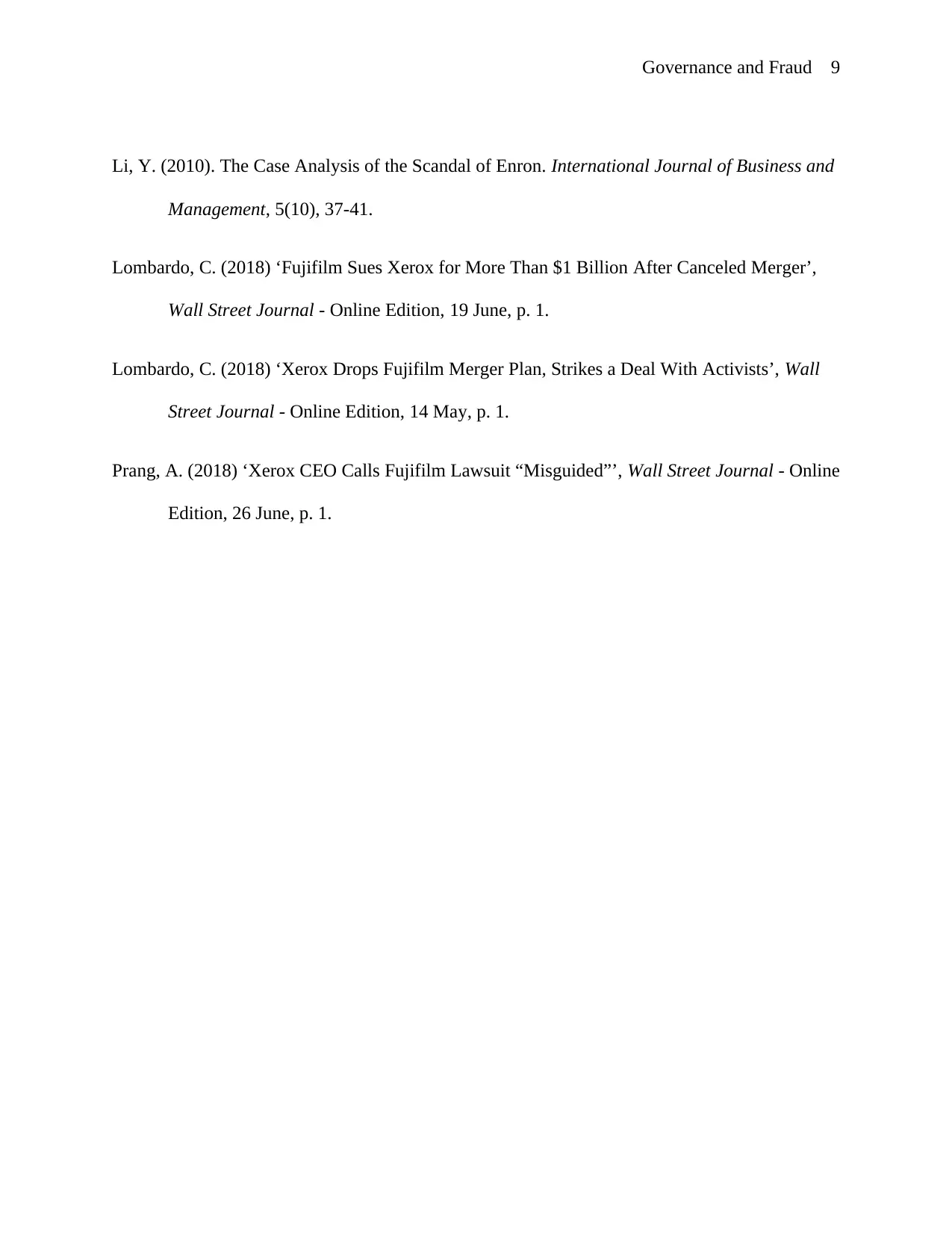
Governance and Fraud 9
Li, Y. (2010). The Case Analysis of the Scandal of Enron. International Journal of Business and
Management, 5(10), 37-41.
Lombardo, C. (2018) ‘Fujifilm Sues Xerox for More Than $1 Billion After Canceled Merger’,
Wall Street Journal - Online Edition, 19 June, p. 1.
Lombardo, C. (2018) ‘Xerox Drops Fujifilm Merger Plan, Strikes a Deal With Activists’, Wall
Street Journal - Online Edition, 14 May, p. 1.
Prang, A. (2018) ‘Xerox CEO Calls Fujifilm Lawsuit “Misguided”’, Wall Street Journal - Online
Edition, 26 June, p. 1.
Li, Y. (2010). The Case Analysis of the Scandal of Enron. International Journal of Business and
Management, 5(10), 37-41.
Lombardo, C. (2018) ‘Fujifilm Sues Xerox for More Than $1 Billion After Canceled Merger’,
Wall Street Journal - Online Edition, 19 June, p. 1.
Lombardo, C. (2018) ‘Xerox Drops Fujifilm Merger Plan, Strikes a Deal With Activists’, Wall
Street Journal - Online Edition, 14 May, p. 1.
Prang, A. (2018) ‘Xerox CEO Calls Fujifilm Lawsuit “Misguided”’, Wall Street Journal - Online
Edition, 26 June, p. 1.
⊘ This is a preview!⊘
Do you want full access?
Subscribe today to unlock all pages.

Trusted by 1+ million students worldwide
1 out of 9
Related Documents
Your All-in-One AI-Powered Toolkit for Academic Success.
+13062052269
info@desklib.com
Available 24*7 on WhatsApp / Email
![[object Object]](/_next/static/media/star-bottom.7253800d.svg)
Unlock your academic potential
Copyright © 2020–2025 A2Z Services. All Rights Reserved. Developed and managed by ZUCOL.





